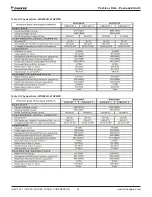
IOM 1322-1 • WATER-COOLED SCROLL COMPRESSOR 10 www.DaikinApplied.com
Application Considerations
Flow Switch
A water flow switch must be mounted in the leaving evaporator
and condenser water lines to prove adequate water flow
before the unit can start. This will safeguard against slugging
the compressors on start-up. It also serves to shut down the
unit in the event that water flow is interrupted to guard against
evaporator freeze-up. There are two options for meeting this
requirement.
1.
A factory-mounted thermal dispersion flow switch.
2.
A “paddle” type flow switch is available from Daikin
Applied for field mounting and wiring. Wire from switch
terminals Y and R to the unit control panel terminals
shown on the field wiring diagram,
. Mount
the flow switch in the leaving water line to shut down the
unit when water flow is interrupted. A flow switch is an
equipment protection control and should never be used
to cycle a unit.
Installation should be per manufacturer’s instructions included
with the switch. There is also a set of normally closed contacts
on the switch that can be used for an indicator light or an alarm
to indicate when a “no flow” condition exists. Flow switches
should be calibrated to shut off the unit when operated below
the minimum listed flow rate for the unit listed on
Provide freeze/condensation protection for any flow switch that
is installed outdoors. Differential pressure switches are not
recommended. They can freeze and fail to indicate a no-flow
condition.
On units with factory-mounted flow switches and where flange
connections (grooved-to-flange adaptors or weld-on flanges)
are to be used, relocating the flow switch is required to allow
for possible future replacement since the flange will interfere
with unscrewing the switch. The following is recommended,
before installing a flange, to avoid interference
1.
Remove the flow switch before and plug the switch
opening in the nozzle.
2.
Install the grooved-to-flange adaptor or weld on flange.
3.
Relocate the flow switch in the water piping outside the
flange, close enough to it that the wire leads will reach
and the switch can still be unscrewed.
NOTE:
A water flow switch must be mounted in the
evaporator outlet water line to signal that there is
water flow before unit will start.
Glycol Solutions
CAUTION
Do not use automotive antifreeze. Industrial glycols must be used.
Automotive antifreeze contains inhibitors that causes plating on copper
tubes. The type and handling of glycol used must be consistent with local
codes.
WGZ units are designed to operate with a leaving chilled
fluid temperature from 15°F (-9.4°C) to 60°F (16°C). Leaving
chilled fluid temperatures below 40°F (4.6°C) result in suction
temperatures at or below the freezing point of water and a
glycol anti-freeze solution is required. When glycol is added
to the chilled water system for freeze protection, recognize
that the refrigerant suction pressure will be lower, cooling
performance less, and water side pressure drop will be
higher. The reduction in performance depends upon the glycol
concentration and temperature. This should be taken into
consideration during initial system design.
Daikin Applied recommends a minimum concentration of 25%
be provided on all glycol applications. Glycol concentrations
below 25% are too diluted for long-term corrosion protection of
ferrous metals and corrosion inhibitors need to be recalculated
and possibly added to the system.Glycol concentrations
greater than 35% are not recommended due to the higher
pressure drops and losses of capacity and efficiency. Glycol
concentrations higher than 35% do not offer any additional
burst protection.
When glycol is required in the chilled water system, reset the
freezestat and low leaving water alarm temperatures. The
freezestat is factory set to default at 36°F (2.2°C). Reset the
freezestat setting to approximately 4° to 5°F (2.3° to 2.8°C)
below the leaving chilled water setpoint temperature.
Glycol in the condenser will have a negligible effect on
performance because glycol at these higher temperatures will
perform with characteristics similar to water.
Condenser Water Piping
Arrange the condenser water so the water enters the bottom
connection of the condenser. The condenser water will
discharge from the top connection. Failing to arrange the
condenser water as stated above will negatively affect the
capacity and efficiency.
Water flow through the condenser should only be during
compressor operation. Pumps may be enabled by the chiller or
BAS.
Field installed water piping to the condenser
must
include:
• Install a cleanable strainer with perforations no larger
than 0.125” (3.2 mm) diameter in the inlet piping .
• Install pressure gauges in the inlet and outlet water lines
to the condenser. Pressure drop through the condenser
should be measured to determine flow on the pressure
drop/flow curves beginning on
It is
recommended
that the field installed water piping to the
chiller include:
• Vibration eliminators are recommended in both the supply
and return water lines to reduce vibration and noise
transmissions to the building.
• A preliminary leak check of the water piping should be
made before filling the system.
•
Shutoff valves to isolate the unit from the piping system
during unit servicing.
• Regular water analysis and chemical water treatment
on the condenser is recommended immediately upon
equipment start-up.
Summary of Contents for IOM 1322-1
Page 4: ......
Page 57: ...Unit Controller Operation www DaikinApplied com 57 IOM 1322 1 WATER COOLED SCROLL COMPRESSOR...
Page 71: ...Unit Maintenance www DaikinApplied com 71 IOM 1322 1 WATER COOLED SCROLL COMPRESSOR...
Page 74: ...IOM 1322 1 WATER COOLED SCROLL COMPRESSOR 74 www DaikinApplied com Troubleshooting Chart...
Page 75: ...Troubleshooting Chart www DaikinApplied com 75 IOM 1322 1 WATER COOLED SCROLL COMPRESSOR...
Page 76: ...IOM 1322 1 WATER COOLED SCROLL COMPRESSOR 76 www DaikinApplied com Troubleshooting Chart...
Page 77: ...Troubleshooting Chart www DaikinApplied com 77 IOM 1322 1 WATER COOLED SCROLL COMPRESSOR...
Page 78: ...IOM 1322 1 WATER COOLED SCROLL COMPRESSOR 78 www DaikinApplied com Troubleshooting Chart...











































